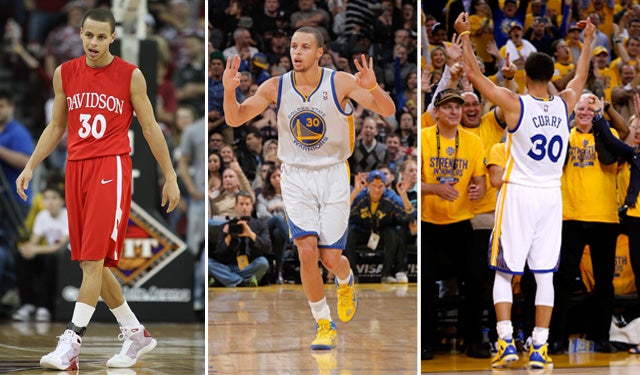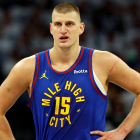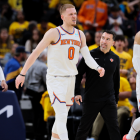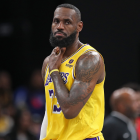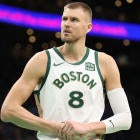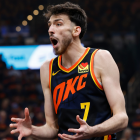We know the story of Golden State Warriors superstar Stephen Curry. It's been an evolving tale of being overlooked, underestimated and climbing above it all to be named the Most Valuable Player in the NBA for the 2014-15 season. He wasn't ranked or recruited in high school. It almost seemed like he was being granted a favor to play at Davidson in college.
But out of nowhere, the small guard with loads of questions and a game with little conscience exploded and became one of the most watchable players of this era. He's not only a superstar, but also the league's Most Valuable Player in only his sixth NBA season, the 19th player to win an MVP award in his first six seasons.
How did we get here? How did a player who wasn't recruited become a mid-major star before turning into the most valuable player in the world on the verge of leading his team to a championship?
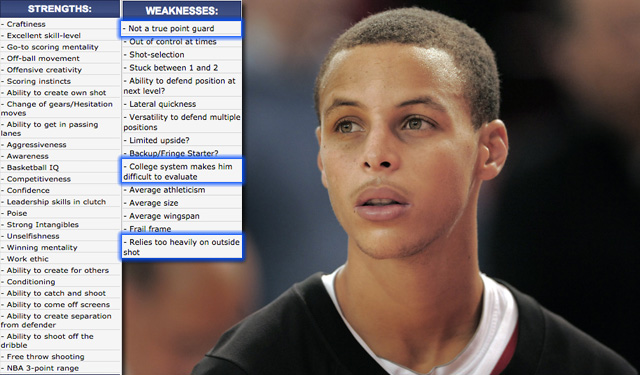
The star of Davidson: Understanding how far Curry has come is understanding what he was coming out of college. It's not like he was a surprise lottery pick; he was ranked in the top five or top 10 on most draft boards, but there were huge questions alongside those rankings. He was an undersized shooting guard, unlikely to have the instincts and playmaking ability of a prototypical NBA point guard. He wasn't looked at as a special athlete, or even quick enough to consistently get off his shot -- or a player strong enough to battle physical NBA guards, especially if he was destined to be a 2-guard.
When you get labeled a tweener, especially at guard, it can be the kiss of death. You're not trusted to run the offense, but you're not trusted to defend your assigned position, either. And these were valid concerns. The talent was there. But was he physically gifted enough to maximize that talent?
Coming out of Davidson after his junior year, Curry didn't profile as a point guard. Mostly, you looked at the way he was utilized in a pick-and-roll set and walked away somewhat dumbfounded that he could be so inefficient at it.
For someone whose points per possession at Davidson ranged from 1.05 to 1.14 and had an effective field goal percentage of anywhere from 55 percent to 61 percent, his pick-and-roll numbers his final season at Davidson were abysmal. He accounted for only 0.735 points per possession as a pick-and-roll ball-handler and his effective field goal percentage was only 37.5 percent.
To put that in perspective, Jonny Flynn's rookie numbers in the pick-and-roll with the Minnesota Timberwolves were 0.766 points per possession with a 41.7 percent on eFG. In his last year at the college level, Curry wasn't better than Flynn against NBA defenses for the first time.
Some of Curry's decisions seemed quite ambitious. He'd try to split soft traps when the defense hedged on a pick-and-roll without making sure to keep his dribble low and close to his body. He take those deep pull-up 3-pointers off the pick and roll, but it wasn't met with the same excitement and anticipation we feel today because we weren't used to that decision.
This video shows problematic decisions scouts and executives saw when evaluating Curry. Looking at them now, it looks like the way we're used to seeing him these days, but his game in college didn't yield the same results. It was like watching a puppy try to troubleshoot getting to a toy or something it wanted to chew on.
The shots were off-balance. The drives were a bit wild and the floaters and layups he attempted were reckless. He was feeling his way as a playmaker because everything was centered on finding him deep shots.
It wasn't all bad, though. He had solid passing instincts at times, as long as he was able to find the space. Despite having a turnover rate of 17.2 percent in the pick-and-roll his last year at Davidson, he was able to find big men rolling to the hoop or lurking from the weak side.
His pick-and-roll playmaking numbers suffered a bit because teammates often failed to finish plays. Kickout passes to shooters. Drop-offs inside to big men hovering around the hoop. Finding the roller over the defense as he dribbled away from the passing target. Curry found teammates enough to show he had a feel for the NBA, but still had a lot of room for improvement.
Even though the shooting percentage wasn't there his junior season, Curry's scoring instincts out of the pick-and-roll showed up. He was better in every other facet (spotting up, cutting, transition, isolation, etc.) for scoring efficiency, but the instincts were there.
Curry occasionally would make off-balance shots and even when he missed layups off splitting the trap, you loved his aggressive scoring mentality. He just needed better understanding of positioning and getting buckets. His numbers shooting off the dribble when coming around on picks were bad. But he was trying to make his instincts work with his abilities while developing the game we see him play today.
He just needed to get to the NBA for it all to flourish.
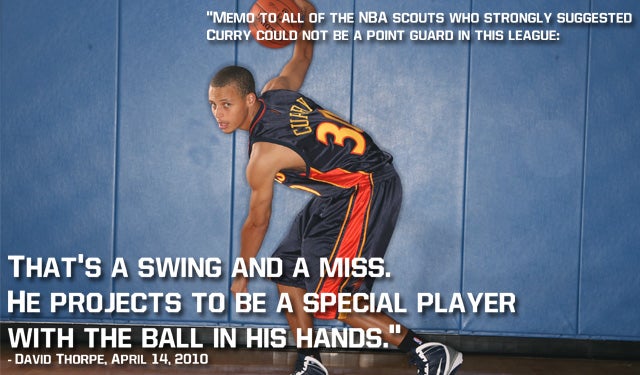
Rookie year -- establishing the shooter: Curry's best skill is obvious. He's the greatest shooter in league history. We didn't know this would be the case coming out of college, and some folks still hesitate to give him such praise because he has a long way to go to match career numbers by Ray Allen and Reggie Miller. However, the volume and accuracy Curry delivers have never before been seen.
Even knowing he was a great 3-point shooter (41.2 percent on 1,004 attempts in three years at Davidson) in college, we've seen plenty of legendary college shooters look pretty good in the NBA without becoming stars. Curry immediately established himself as a great shooter in his rookie season. During his final season at Davidson, Curry was a good spot-up shooter but it wasn't something he did much.
Synergy Sports has spot-up opportunities for Curry as only 8.9 percent of his offense during his junior year. It makes sense it would be that low considering he had to do most everything for his team. He made 40.9 percent of this shots with a 54.5 effective field goal percentage. His guarded catch-and-shoot attempts yielded an eFG of 52.8 percent, while unguarded catch-and-shoot shots gave him an eFG of 61.2 percent. He knocked down 34.7 percent of his jumpers off the dribble (42.1 percent eFG).
He could shoot but wasn't set up nearly as much as necessary for those percentages to really spike.
Once he got to the NBA, those attempts skyrocketed. His percentage of scoring opportunities coming on spot-up attempts jumped to 16.8 percent, nearly double his final Davidson season percentage. And when you give a shooter those kinds of opportunities, you're going to see the natural talent and hard work produce results.
Curry was an elite spot-up shooter instantaneously. His eFG on spot-up attempts was a ridiculous 70.4 percent, and he was the top scorer from spot-up opportunities. Only Jason Kidd (66.8 eFG) and Anthony Morrow (70.7 eFG) were better volume shooters on guarded catch-and-shoot attempts (Curry had an eFG of 66.6 percent). His unguarded accuracy (69.4 percent eFG) put him in the 91st percentile.
He set the record (later to be broken by Damian Lillard) for most 3-pointers made by a rookie. The kid could shoot which helped unlock playmaking opportunities because defenses had to crowd him to prevent the shot.
Curry saw so much more of the floor because of the spacing the NBA game provides. Teams couldn't load up on Curry in the NBA like they did with the college rules. Since he was a rookie, teams didn't know just how deadly he could be. His eFG rose a full 10 percent in pick-and-roll situations and he went from generating 0.781 points per possession with shooting or passing in the pick-and-roll his junior year to 0.946 points per possession as a rookie in the pros.
That's a major jump in production, even though the NBA is supposed to be much harder, especially for rookie point men. Curry went from turning the ball over 17.2 percent of the time in pick-and-roll situations his final college season to 13.4 percent as an NBA rookie. He was better across the board in every facet and it looked like he had a real future as an NBA lead guard.
He just needed to stay healthy to build on his experience.
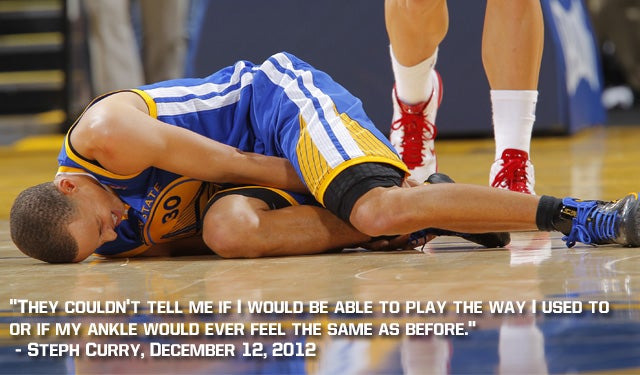
Development slowed by ankle issues: He developed even more the next two season, but was derailed by setbacks. In his second NBA season, Curry became a more efficient scorer as a pick-and-roll ball-handler, transition weapon, isolation creator and off screens and hand-offs. His biggest jump came as a transition scorer though.
The Curry we see now, looking to become a threat as soon as he crosses half court, started to emerge. As a rookie, Curry scored 0.943 points per possession and had an eFG of only 52.6 percent. It was an improvement from his final days at Davidson, but it wasn't good enough for the NBA. He was in only the 16th percentile for transition scorers. In his second season, that efficiency made a huge leap.
Curry looked more comfortable attacking the basket in transition and started becoming that pull-up 3-point artist who dazzles us now. His scoring efficiency jumped to 1.15 points per possession (48th percentile) and his eFG jumped to 61.6 percent. He wasn't the most dangerous threat in transition, but he started to understand how he could confuse a defense by exploiting the transition 3.
Unfortunately, he couldn't build much from his second year to his third year because of multiple ankle sprains in 2010-11 created ligament damage. During May of 2011, he had ankle surgery to repair the damage. He'd have to wait to get back on the court under new coach Mark Jackson because the 2011 NBA Lockout delayed the start of the season.
Before the season finally began, Curry again sprained his ankle. In 2011-12, he improved across the board in most scoring situations, even jumping up to an absurd 72.2 percent effective field goal percentage on spot-up jumpers. But he played only 26 of 66 games because of ankle issues, and another ankle surgery seemed to set him back and put serious doubt into his future as a star.
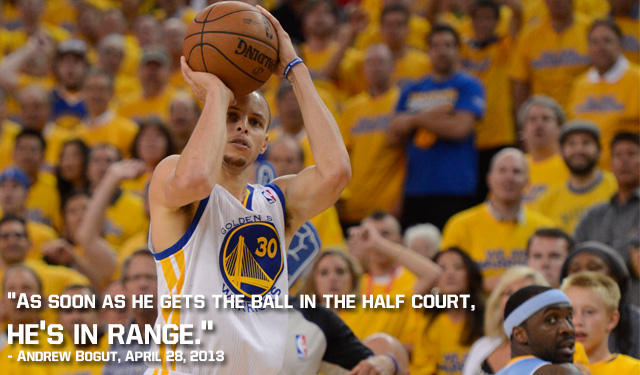
Burning down buildings in his ascension to stardom: The half-court line has a function. It evenly splits the two ends of the court. The line was implemented in the 1930s to prevent a "soccer style" of offense in which teams could use the court to play "keep away." This was before the shot clock was introduced in 1954, so you could really keep the defense running around using the entire length of the court. Since the half-court line was implemented, it's served as a barrier for the offense.
In the 2012-13 season, the half-court line finally had a new significance. As soon as Curry crossed it with the ball, defenses felt angst. It was impossible to know what he was going to do with the ball, but you knew you had to take away his space then because you couldn't afford to give up morale-shattering deep 3s.
It's also the season Curry established himself as the most lethal outside shooter in NBA history. He broke Allen's record (269) for 3-pointers made in a season (272). He hit with blistering regularity (45.3 percent) from downtown, adding the most lethal accuracy to the highest volume anybody could imagine.
At the trade deadline in the previous season, the Warriors traded Monta Ellis, making Curry the primary ball handler of the future. He no longer shared time as a playmaker. He was the Warriors' true point guard, the leader of the present and future. And this liberation, coupled with a new defensive mindset, helped the Warriors take the next step.
Curry was the great equalizer for the Warriors in every respect. His transition scoring jumped to 1.228 PPP and his eFG in these scoring situations rose to 69.6 percent. Of the high volume transition scorers, Curry was bested only by LeBron James and Kevin Durant in efficiency and percentage, and Curry didn't have an alien body to do most of his work at the rim.
He posted career highs in points, assists and minutes as he lead the Warriors to their first playoff berth since 2007. And it was in that first round against the Denver Nuggets that you couldn't help but notice where the league was headed.
Down 2-1 in the series and trying to steal a game back in Oakland, the Nuggets were hanging on by a thread after the first half. By George Karl's admission during the series, the Nuggets had stolen Game 1 on an Andre Miller layup. Curry answered back with 30 points and 13 assists in Game 2 in a blowout victory, and then had 29 points and 11 assists in Game 3 as the Warriors hung on to win.
In the third quarter of Game 4, Curry torched the Nuggets' hopes of winning the series. He scored 22 points in the third quarter on his way to 31 overall, as the Warriors took a 3-1 series lead. They closed it out in Game 6 before losing to the Spurs in the next round.
As the 2013-14 season started, expectations for Curry and the Warriors rose for the first time. They announced their presence in the 2013 playoffs and that presence was going to be challenged every game. The only way to meet those expectations was with Curry leading the team to greater heights. Any lingering doubts Curry could be a playmaker and a "true point guard" in this league were completely eradicated.
Only Ellis generated more points in the pick-and-roll with shooting or passing than Curry in 2013-14, and Curry's eFG was nearly three percentage points higher. Goran Dragic of the Phoenix Suns is the only high volume pick-and-roll creator who shot a better eFG (by 0.9 percent) than Curry. He was the pick-and-roll in 2013-14 and it was a big reason the Warriors were so dangerous.
They improved to 51 wins -- their highest win total in 20 years -- Curry not only was named to the All-Star Game for the first time, but also was second-team All-NBA. The Warriors would be eliminated in seven games in the first round by the Clippers, but began to setting their sights on the highest of goals.
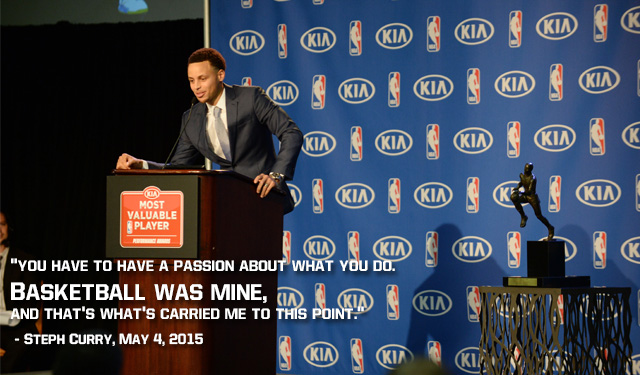
The NBA's Most Valuable Player: As we sit one playoff round away from finishing the 2014-15 season, there's no doubt this campaign has belonged to Curry.
He dominated the highlights. He dominated the MVP discussion most of this season and ran away with the voting (100 of the 130 first-place votes). Not only was he voted in as an All-Star starter, he was the leading vote-getter. He was a unanimous decision as All-NBA First Team (along with LeBron).
And Curry earned all of those accolades. He was the best player on a 67-win team that mosstly blew away the rest of the league every night. They were one of the most dominant home teams we've ever seen. Curry was so good as the leader he often rested in the fourth quarter.
He was the third best spot-up shooter, behind Klay Thompson and Kyle Korver. Curry was the best pick-and-roll creator. He even beat his record for 3-pointers made in a season by knocking down 286.
For Curry, 2014-15 was the most efficient scoring season of his career. Tracking his progression from his final year at Davidson to this MVP campaign, you can see he didn't have the highest marks in every major scoring situational category of his career, but they average out to his most productive year.
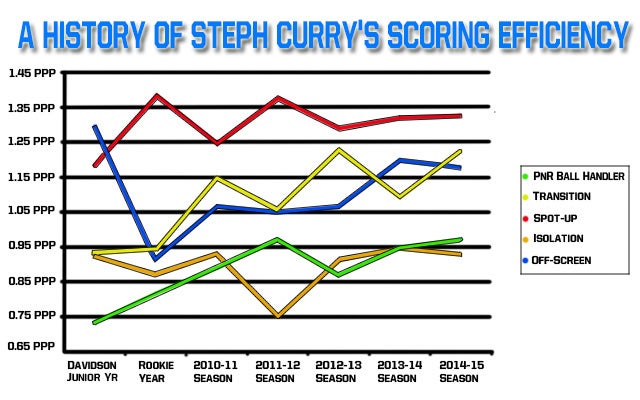
The same goes for his shooting efficiency. Across the board, Curry had near highs in effective field goal percentage for the five major scoring situations. They also average out to the best shooting season of his career.
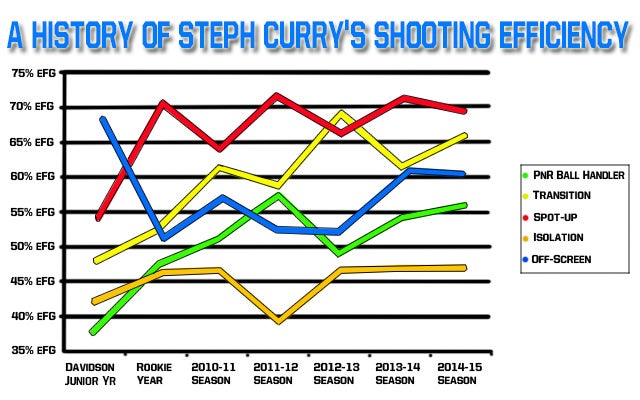
Curry has answered every question since he entered the NBA Draft. He wasn't a true point guard. He wasn't quick enough to be a lead guard nor big enough to be a 2-guard. He wasn't supposed to be this good and he probably wasn't even supposed to get this far. We've seen plenty of big time college scorers from smaller schools flame out once they face tougher defenses and bigger, more physical NBA players.
That's not what happened with Curry. Instead, he set fire to the league.
There are no longer questions of whether Curry can get the job done; there are only questions of whether you can possibly stop him. More terrifying, he's only 27 and still getting better.
